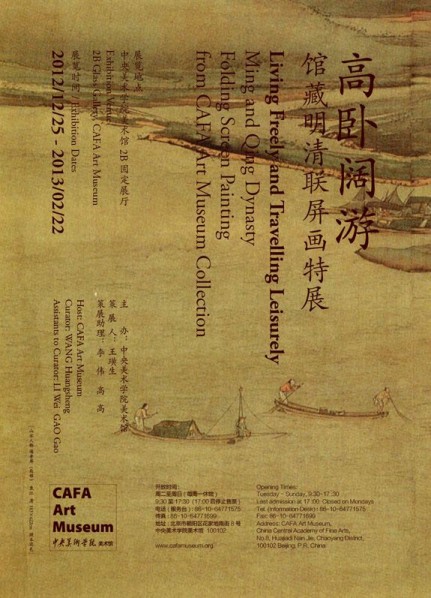
The last featured exhibition hosted by CAFA Art Museum at the end of 2012 is, “Living Freely and Traveling Leisurely: Ming and Qing Dynasty’s Folding Screen Painting from CAFA Art Museum Collection”. It is shown in the 2B Glass Gallery CAFA Art Museum, although it is a small room of no more than ten square meters, there are 6 pieces of large-scale Chinese paintings showing the public the grand landscape of artists’ minds: a twelve folding screens painting “The Landscape with Figures” is of 6 meters width, including pavilions, terraces and open halls of Jiangnan style, cliffs of Tai Hang Mountain, as well as some rivers flowing at different speeds, a three-fold screen painting “E’mei Mountain in Half of the Sky”, with the inscription: Playing the flute alone on E’mei Mountain as submerged in half of the sky, every place is frozen in May”, displaying a lofty sentiment or a sense of loss.
We cannot underestimate these 6 paintings, all of which are rare pieces, as the inscription states: “an impressive grand view”, written by oil painting master Xu Beihong about the twelve folding screens painting “Landscape with Figures”, and there is not any inscription and literal information section on the four-fold screen painting “Stones”, but the most important to us is that it is rare to be able to see them.
Why does CAFA Art Museum choose “folding screen painting” as the last important show of the year? Wang Huangsheng, Director of CAFA Art Museum and the Curator of the exhibition, said: “It is easy to select several pieces of important works for an exhibition of Ming and Qing Dynasty domestic paintings, but it is rare that an exhibition only includes folding screen paintings, which is a priority feature of CAFA Art Museum collection.” And he also said that it displayed more than half of the CAFA collection of folding screen paintings.

Yuan Jiang, twelve folding screens painting “Landscape with Figures”, Qing Dynasty, 183 × 622 cm, colored ink on silk
It is without doubt that the champion of the “stars” is the “The Landscape with Figures” by Yuan Jiang, a painter living at the period of “Flourishing Ages of Kang Xi and Qian Long” in the Qing Dynasty. First of all, it is big, the 12 pieces of folding screens are 6 meters in width, it is said that it is the biggest ancient folding screen in the world. Wang Huangsheng said that it is selected by Victoria & Albert Museum as a master work for the exhibition next October, including a large number of selected works from the Dynasties of Song, Yuan, Ming and Qing.
In fact, it is one of the five “treasures” of the CAFA Art Museum. There are inscriptions by Xu Beihong and Qi Baishi. It is said that it was collected by Huang Yanghui, a student of Xu Beihong when he was teaching in the Central University. Once Huang Yanghui showed this painting to Xu Beihong, it was given fabulous praise and he made the inscription without reservation, the meaning of which is that the Jialing River drawn by Wu Daozi and Li Sixun are not better than this work, and he thought that the capabilities of the masters such as Dong Qichang, Wang Shimin, Wang Jian, Wang Hui, and Wang Yuanqi, and some literati artists such as Wu Zhen and Hun Shouping could not catch up with Wu Jiang’s.
As an art historian, Wang Huangsheng said, “It is a famous work, but I mainly want to show the audience ‘Chinese Painting with Architecture’, an old art form that is fading from our world.” It originated in the Jin Dynasty, an extremely unique category of Chinese painting. It is named as using a ruler to outline, and is an art form that is suitable for painting architecture. Displaying the Jiangnan architecture in a large-scale, the twelve folding screens painting “Landscape with Figures” by the master Yuan Jiang, is the best of this art form.

Gong Xian, “E’mei Mountain in Half of the Sky Figure”, Qing Dynasty, 283 ×79 cm, ink on paper
When asked why the exhibition is entitled “Living Freely and Traveling Leisurely”, Wang Huangsheng explained, when ancient Chinese people were sitting or lying at home, they could travel and sightsee landscape from their homes as the paintings brought the scenes into the home. Because most ancient furniture had folding screens, often displaying a large-scale landscape that a onlooker could then travel through heaven and earth from the painting. Folding screen painting has evolved from the folding screens.
Apart from the rare works, the exhibition also has another important feature, i.e. annotating very informatively, there are several thousand words of introductory text on the labels. Looking at “Stones” the four screens painting by Pu Hua from the late Qing Dynasty as an example, there are three parts to its literal information: firstly, a brief introduction of the work, secondly, a brief introduction to the artist, thirdly, rewriting all the inscriptions in the block letters. The artist’s inscription is right below the side of the painting: Pu Hua is asked to paint a painting themed stone, and he painted four in three years, one in each of the first two years, and two in the last year, keeping pace with the time (brief meaning).
Wang Huangsheng said: “Not all of the exhibition is luxurious or on a large-scale, the key is to make it an academic exhibition, realized by the artistic text related to the artworks.
The exhibition lasts until February 22, 2013.
Translated by Chen Peihua and edited by Sue/CAFA ART INFO
About the exhibition
Duration: December 25, 2012 – February 22, 2013
Venue: 2B Glass Gallery CAFA Art Museum
Host: CAFA Art Museum
Curator: Wang Huangsheng
Assistants Curator: Li Wei and Gao Gao




























